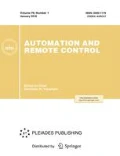Abstract
We develop models and algorithms to control the process of landing aircraft under uncertainty of their positions in space caused by unfavorable, unforeseen external influences. As the objective function we consider the execution time of the dispatcher’s commands, and as constraints we introduce requirements for the safety of aircraft. Based on the developed formalism of generalized synchronization of linear automata, we develop an approach that makes it possible to reduce this problem to an integer linear programming problem. We consider an example of the use of the developed models and methods for controlling the aircraft landing process.
Similar content being viewed by others
References
Rezchikov, A., Kushnikov, V., Ivaschenko, V., Bogomolov, A., Filimonyuk, L., and Kachur, K., Control of the Air Transportation System with Flight Safety as the Criterion, in Automation Control Theory Perspectives in Intelligent Systems, Proc. 5th Computer Science On-line Conf. 2016 (CSOC2016), Springer Int. Publishing Switzerland, 2016, vol. 3, pp. 423–432.
Bogomolov, A.S., Preventing Critical Combinations of Events in an Aviation Transportation System, in Proc. VII Int. Sci. Conf. “Computer Science and Information Technologies,” Saratov, 2016, pp. 79–84.
Rezchikov, A.F. and Bogomolov, A.S., Critical Combinations of Events as Reasons for Failures in Human-Machine Systems, in Proc. VIII Int. Conf. “Managing Large-Scale Systems Development” (MLSD 2015), Moscow, 2015, vol. 1, pp. 130–135.
Rezchikov, A.F. and Tverdokhlebov, V.A., Models and Methods for Finding Reasons for Critical Situations in Complex Systems, in Proc. VIII Intl. Conf. “Managing Large-Scale Systems Development” (MLSD 2015), Moscow, 2015, vol. 1, pp. 8214–8223.
Klyuev, V.V., Rezchikov, A.F., Kushnikov, V.A., Tverdokhlebov, V.A., Ivashchenko, V.A., Bogomolov, A.S., and Filimonyuk, L.Yu., Analysis of Critical Situations Caused by an Unfortunate Coincidence, Kontrol. Diagnost., 2014, no. 7, pp. 12–16.
Klyuev, V.V., Rezchikov, A.F., Bogomolov, A.S., and Filimonyuk, L.Yu., The Concept of a Complex Resource for Studies of Security for Human-Object-Environment Systems, Kontrol. Diagnost., 2013, no. 8, pp. 44–55.
Bogomolov, A.S., Complex Control over Resources of Complex Human-Machine Systems, Izv. Saratov. Gos. Univ, Ser. Mat. Mekh. Informatika, 2013, vol. 13, no. 3, pp. 83–87.
Klyuev, V.V., Rezchikov, A.F., Bogomolov, A.S., Ukov, D.A., and Filimonyuk, L.Yu., Systems Approach to the Problem of Estimating Residual Resource in Human-Machine Systems, Kontrol. Diagnost., 2011, no. 8, pp. 9–13.
Kushnikov, V.A., Rezchikov, A.F., and Tsvirkun, A.D., Sontrol in Man-Machine Systems with Automated Correction of Objectives, Meitan Kexun Jishu, 1998, vol. 26, no. 11, pp. 168–175.
Rezchikov, A., Dolinina, O., Kushnikov, V., Ivaschenko, V., Kachur, K., Bogomolov, A., and Filimonyuk, L., The Problem of a Human Factor in Aviation Transport Systems, in Proc. 3rd Int. Conf. on Computing, Technology and Engineering (ICCTE 2016), Singapore, 2016, pp. 16–20.
Novozhilov, G.V., Rezchikov, A.F., Neimark, M.S., Bogomolov, A.S., Tsesarskii, L.G., and Filimonyuk, L.Yu., The Problem of Critical Combinations of Events in the “Crew–Aircraft–Dispatcher” System, Obshcheross. Nauch.-Tekhn. J. “Polet,” 2015, no. 2, pp. 10–16.
Novozhilov, G.V., Rezchikov, A.F., Neimark, M.S., Bogomolov, A.S., Tsesarskii, L.G., and Filimonyuk, L.Yu., Human Factor in Aviation Transport Systems, Obshcheross. Nauch.-Tekhn. J. “Polet,” 2013, no. 5, pp. 3–10.
Bogomolov, A.S. and Speranskii, D.V., On an Optimal Synchronizing Experiment with Linear Automata, J. Comput. Syst. Sci. Int., 2002, vol. 41, no. 3, pp. 397–403.
Trahtman, A., Modifying the Upper Bound on the Length ofMinimal SynchronizingWord, Fundamentals Comput. Theory, Lect. Notes Comput. Sci., 2011, vol. 6914, pp. 173–180.
Gill, A., Linear Sequential Circuits; Analysis, Synthesis, and Applications, New York: McGraw-Hill, 1966. Translated under the title Lineinye posledovatel’nostnye mashiny, Moscow: Nauka, 1974.
On Establishing the Aviation Rules “Order of Operation for Radio Communication in the Air Space of the Russian Federation.” Directive of the Russian Ministry of Transportation, September 26, 2012, no. 362.
Author information
Authors and Affiliations
Corresponding author
Additional information
Original Russian Text © A.F. Rezchikov, V.A. Kushnikov, V.A. Ivashchenko, A.S. Bogomolov, L.Yu. Filimonyuk, 2018, published in Avtomatika i Telemekhanika, 2018, No. 10, pp. 154–163.
Rights and permissions
About this article
Cite this article
Rezchikov, A.F., Kushnikov, V.A., Ivashchenko, V.A. et al. Models and Algorithms of Automata Theory for the Control of an Aircraft Group. Autom Remote Control 79, 1863–1870 (2018). https://doi.org/10.1134/S0005117918100107
Received:
Published:
Issue Date:
DOI: https://doi.org/10.1134/S0005117918100107



